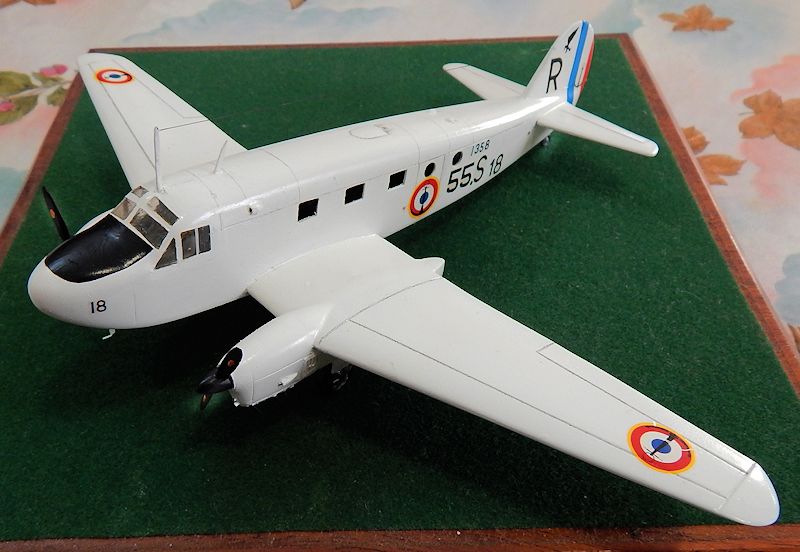
Airmodel 1/72 Caudron C.445 Goeland
| KIT #: | AM-087 |
| PRICE: | 13.50 Euros |
| DECALS: | None supplied |
| REVIEWER: | Carmel J. Attard |
| NOTES: | Vacuform kit with resin parts |

| HISTORY |
Developed to satisfy the need for a fast, economical and comfortable transport,
the C.445 Goeland (Sea Gull) appeared in 1934. The wings were made of spruce and
plywood and carried ailerons and trailing edge flaps. Fuselage was largely
plywood and had plywood skin wing except for nose section and upper decking,
which had stressed sheet metal covering.
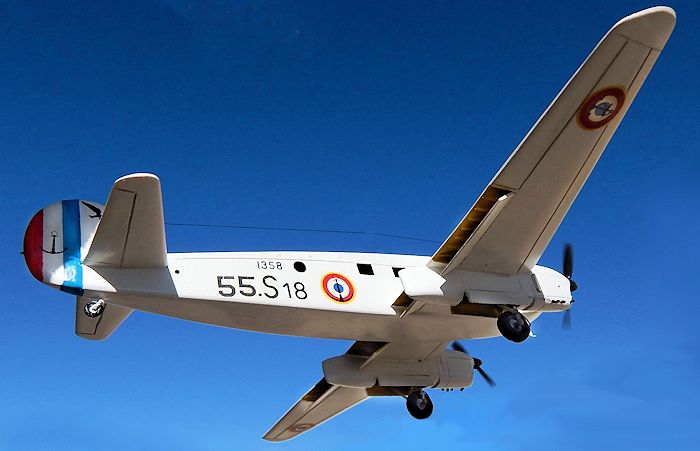 The Goeland was one of the most successful commercial aircraft produced in
Europe in the 1930s. In its basic passenger configuration the Goeland offered
cabin accommodation for 6 passengers. Baggage holds were located forward and aft
and a toilet was situated at rear of the cabin. Internal layout varied according
to role. The Goeland had a maximum speed of 186 mph at sea level and was powered
by two Renault 6Q-00/01 or 6Q-08/09 Bengali 6 inverted inline engines rated at
220hp.
The Goeland was one of the most successful commercial aircraft produced in
Europe in the 1930s. In its basic passenger configuration the Goeland offered
cabin accommodation for 6 passengers. Baggage holds were located forward and aft
and a toilet was situated at rear of the cabin. Internal layout varied according
to role. The Goeland had a maximum speed of 186 mph at sea level and was powered
by two Renault 6Q-00/01 or 6Q-08/09 Bengali 6 inverted inline engines rated at
220hp.
The Goeland was produced in several variants with factory designations C.440 to
C.449. Chief among was the military C.445m light transport, and crew trainer for
the Armee de l’Aire. Upon occupation of France, 55 Goelands were captured by the
Luftwaffe, and production of the type was allowed to continue to equip Vichy Air
Force, the Luftwaffe and Lufthansa. A bomber trainer version was fitted with a
glazed nose.
As a civil type the Goeland became increasingly popular from 1935 onwards in
numerous companies operating in France and Africa, including Air Bleu Mail
Company and the Regie Air Afrique and Air France and other French operators. The
type was sold to Yugoslavia’s Aeroput and also to operate in Bulgaria and Spain.
In 1940 two C.445ms were supplied to Belgian Aeronautique Militaire.
The Goeland remained in production up to the outbreak of WWII, the principal
model being the C.445 which was also adopted by the Armee’de l’Aire as the
C-445m and used for variety of tasks including communication duties and crew
training. In all more than 1,700 examples of these small twin-engined
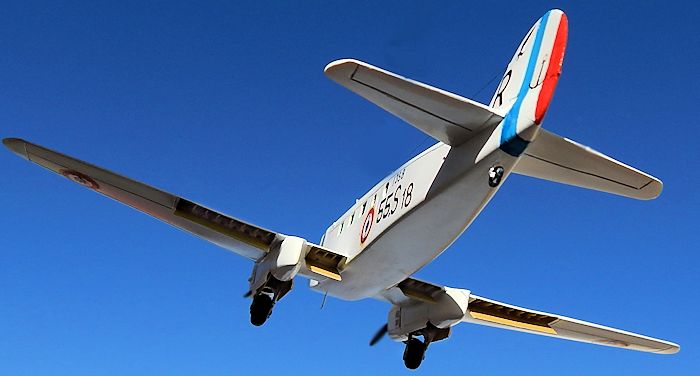 aircraft
were completed and production carried on well into post-war years. During the
war itself the Goeland was called upon to carry out service for both the French
and the Germans. After the war Goelands were in service with the Air Force crew
training and postal flights while others continued to serve for a number of
years with the Armee de l’Aire.
aircraft
were completed and production carried on well into post-war years. During the
war itself the Goeland was called upon to carry out service for both the French
and the Germans. After the war Goelands were in service with the Air Force crew
training and postal flights while others continued to serve for a number of
years with the Armee de l’Aire.
The model is completed as C.445m Goeland that served in one of France’s
scattered overseas empire bases and in this case in North Africa, Morocco,
attached to Escadrille 55.S. In service with French Navy these were finished in
different liveries and were either painted white as depicted by the model or an
overall silver finish just like aircraft 55.S.19 with black S on fin.
| THE KIT |
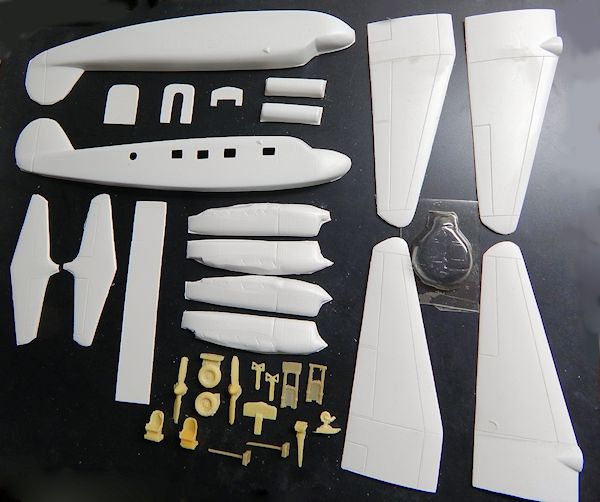 The model came from Airmodel Products following their practice of producing a
series of categories of aircraft and the Goeland falls among the post was French
types. The kit is a re-release of earlier production in fact this time it comes
with resin detail parts which means it reaches the new level of improved models
as would be expected from Airmodel.
The model came from Airmodel Products following their practice of producing a
series of categories of aircraft and the Goeland falls among the post was French
types. The kit is a re-release of earlier production in fact this time it comes
with resin detail parts which means it reaches the new level of improved models
as would be expected from Airmodel.
The kit consists of a sealed bag with two white plastic sheets containing 4 wing
parts, 2 tail plane items, four engine nacelle halves, wheel well doors, a deck
and two bulkheads. Resin parts comprise two main wheels and legs, a tail wheel,
two propellers, two seats, two control wheels and an instrument panel. Clear
acetate parts for the cockpit canopy.
The components seem to be accurate in size and accuracy and conform to the scale
plan view provided which itself looked basic but useful to refer to during
assembly of the model. The engine nacelles look too basic at first sight but
they are accurate in size and conform to the side view drawings.
| CONSTRUCTION |
 windows were then cut out
using drill and a pointed modelling knife and shaping by filing. The cockpit
area was then cut so that it will receive the acetate canopy at a later stage.
It may be desired to cut the windscreen and deck skylight and fill these
openings with Kristal Kleer if one prefers to do away with the kit canopy.
windows were then cut out
using drill and a pointed modelling knife and shaping by filing. The cockpit
area was then cut so that it will receive the acetate canopy at a later stage.
It may be desired to cut the windscreen and deck skylight and fill these
openings with Kristal Kleer if one prefers to do away with the kit canopy.
Passenger deck and cockpit floor was then cut along with the two bulkheads and
these were fixed to one side of fuselage. Cockpit instruments and seats etc
glued in place, interiors painted in cockpit green and two crew figures in
French gear painted and added to the seats.
Working on the wings I went the extra step and cut off the flaps, detailed the
flaps interior area adding wing spar items shaped from plastic card. Wing parts
are fixed together and detail added accordingly. The engine nacelles were then
given due attention and wing wheel wells cut and detail added. This consisted of
cutting the front rectangular air intake and adding two small round intakes to
each engine nacelle front. Reference to drawing showed at which side these had
to be cut. Four exhaust pipes were also added in form of hollow needles that
were cut to a small size after reference to photos downloaded on line.
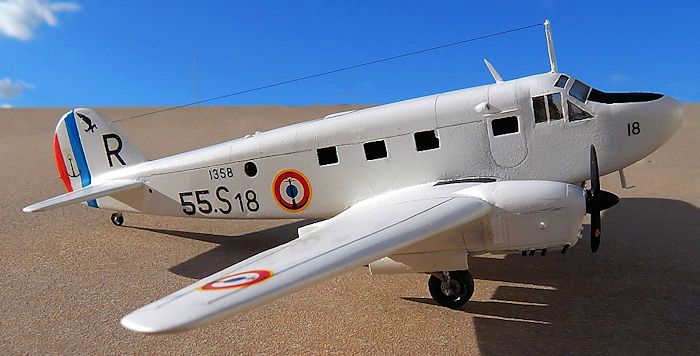 Whereas the tail plane had indication at which level to the fuselage it was to
be fixed it was not the same for correct placement for the main wings. Reference
to the front elevation and plan view one could easily discern the exact place to
fix the wings. I also added dowels to ensure that wings are correctly aligned.
Filler was required at roots. The engine nacelles were then added to the wings
ensuring their correct position and that they are parallel to each other.
Whereas the tail plane had indication at which level to the fuselage it was to
be fixed it was not the same for correct placement for the main wings. Reference
to the front elevation and plan view one could easily discern the exact place to
fix the wings. I also added dowels to ensure that wings are correctly aligned.
Filler was required at roots. The engine nacelles were then added to the wings
ensuring their correct position and that they are parallel to each other.
Some other extra work included lowering the flaps at an angle; adding legs
guards from metal wire; adding small outlet ducts on roof; control links to the
rudder; adding three antennas, drilling landing light opening at nose front,
trimmed all the resin parts particularly the two blade resin propellers; scored
several panel lines and position of control surfaces.
| COLORS & MARKINGS |
As mentioned earlier the Goeland was completed to represent one belonging to the
French Navy attached to Escadrille 55.S based at Morocco circa 1950-53. It was
overall white with black serial number and squadron number. I used Revel gloss
white, which I found it retains its bright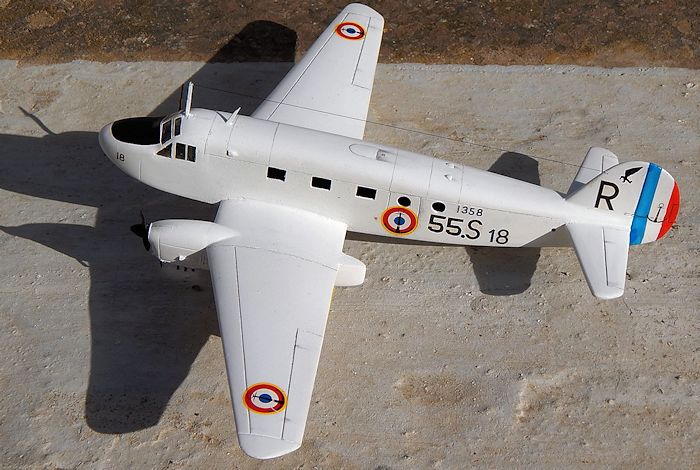 whiteness with time. Letters and
numbers all came from model decal sheets while the speed bird motif on tail fin
was hand painted on a decal sheet and applied to the model. French Navy roundels
came from a kit of F4U7, Italeri kit.
whiteness with time. Letters and
numbers all came from model decal sheets while the speed bird motif on tail fin
was hand painted on a decal sheet and applied to the model. French Navy roundels
came from a kit of F4U7, Italeri kit.
| CONCLUSIONS |
I was surprised to note that the Goeland never made it in injected form considering that over 17 hundreds of the type were produced over several years since before the war. Overall I felt that this was an important aircraft in view that it also participated in the Spanish civil war and during WWII. I recommend the Airmodel kit of the Caudron C.445 to anyone having basic vac form model building skill and a little patience to build the kit.
Carmel J. Attard
February 2015 If you would like your product reviewed fairly and fairly quickly, please contact the editor
or see other details in the
Note to
Contributors.